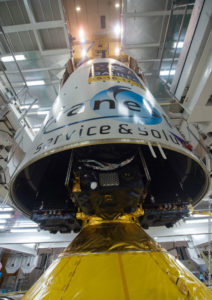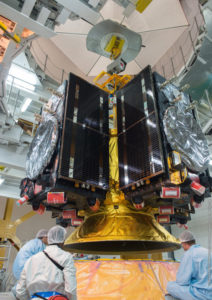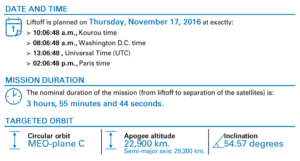Antonianna, Lisa, Kimberley and Tijmen – the latest Galileo spacecraft for Europe’s satellite navigation constellation – have been integrated with their Ariane 5 launcher in French Guiana for a November 17 Arianespace mission.
The four 715 kg satellites – named for winners of a European children’s drawing contest – were attached to their dispenser as a combined ‘upper composite’ and transported to the final assembly building on 31 October.
The next step saw them put on top of the upper stage of their customised launcher. Finally, on 3 November, the quartet was enclosed within a protective fairing – the last time they were seen by human eyes – to protect them from the onrushing atmosphere during ascent.
Arianespace previously has lofted 14 Full Operational Capability (FOC) and In-Orbit Validation (IOV) satellites for Galileo from French Guiana with seven missions utilizing its medium-lift Soyuz vehicle, along with two other Soyuz flights from the Baikonur Cosmodrome that deployed the GIOVE-A and GIOVE-B experimental satellites.

Fairing lowered over the heavy-lift vehicle and its four Galileo satellites to complete launcher build-up
Launcher ready
In the following week, the rocket was prepared for takeoff, including filling its cryogenic upper stage, in preparation for the move to the launch pad on Tuesday, 15 November.
This is the first of those missions that is using a heavy-lift Ariane 5 ES version with an enhanced storable propellant upper stage that allows for reignition and long coast phases during the mission. These upgrades maximize the launcher’s performance for deploying the Galileo spacecraft – which will have a combined mass of 2,865 kg. at liftoff (sized at 2.7 x 1.2 x 1.1 meters) – configured on a payload dispenser that will release them in pairs into circular orbit.
In development since 2012, this new Ariane variant has evolved from the version used to place ESA’s 20 t Automated Transfer Vehicle vehicle into low orbit. The new launcher has to carry a lighter payload but needs to take it up to the much higher altitude of 22 900 km.
The target orbit is actually 300 km under the Galileo constellation’s final working altitude. This leaves Ariane’s upper stage in a stable ‘graveyard orbit’, while the four Galileos manoeuvre themselves up to their final set height.
The decision to proceed with this launch was taken after in-depth analysis of two recent anomalies occurring in rubidium atomic clocks aboard Galileo satellites in orbit.
Highly accurate timing is core to satellite navigation. Each Galileo carries four atomic clocks to ensure quadruple redundancy of the timing subsystem: two Passive Hydrogen Maser clocks plus two Rubidium Atomic Frequency Standard (RAFS) clock.
Investigations jointly conducted by ESA and industry point to a short circuit in these two RAFS units. The ultimate objective of the fourfold redundancy on each satellite is to ensure operations over their planned lifetime.
Taking into account the redundancy and considering that the upcoming launch will increase the constellation’s overall robustness,it has been decided to maintain the mid-November launch date.
With Ariane 5 now complete, it is being readied for rollout next week to the Spaceport’s ELA-3 launch complex in advance of its November 17 flight, which is set for liftoff at exactly 10:06:48 a.m. local time in French Guiana.
Arianespace’s first Ariane 5 launch for Galileo
For its ninth launch of the year, and the sixth Ariane 5 liftoff from the Guiana Space Center (CSG) in French Guiana during 2016, Arianespace will orbit four more satellites for the Galileo constellation.
This mission is being performed on behalf of the European Commission under a contract with the European Space Agency (ESA).
For the first time, an Ariane 5 ES version will be used to orbit satellites in Europe’s own satellite navigation system.
At the completion of this mission, designated Flight VA233 in Arianespace’s launcher family numbering system, 18 Galileo spacecraft will have been launched by Arianespace.
Arianespace is proud to deploy its entire family of launch vehicles to address Europe’s needs and guarantee its independent access to space.
The launch will be performed from Ariane Launch Complex No. 3 (ELA 3) in Kourou, French Guiana.
The Launch Readiness Review (LRR) will take place on Monday, November 14, 2016 in Kourou, to authorize the start of operations for the final countdown.


